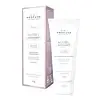What's inside
What's inside
 Key Ingredients
Key Ingredients

 Benefits
Benefits

 Concerns
Concerns

 Ingredients Side-by-side
Ingredients Side-by-side

Water
Skin ConditioningGlycerin
HumectantDicaprylyl Ether
EmollientPropylheptyl Caprylate
EmollientButylene Glycol
HumectantGlyceryl Stearate Citrate
EmollientGlycol Palmitate
EmulsifyingSqualane
EmollientSucrose Stearate
EmollientMangifera Indica Seed Butter
Skin ConditioningPentylene Glycol
Skin ConditioningAcrylates/C10-30 Alkyl Acrylate Crosspolymer
Emulsion StabilisingCaprylyl Glycol
EmollientCarnosine
Skin ConditioningHydroxyethyl Acrylate/Sodium Acryloyldimethyl Taurate Copolymer
Emulsion StabilisingMannitol
HumectantXylitol
HumectantTocopherol
AntioxidantSalvia Miltiorrhiza Flower/Leaf/Root Extract
Skin ConditioningRhamnose
HumectantGlycine Soja Oil
EmollientPolysorbate 60
EmulsifyingSorbitan Isostearate
EmulsifyingPalmitoyl Tetrapeptide-10
Skin ConditioningWater, Glycerin, Dicaprylyl Ether, Propylheptyl Caprylate, Butylene Glycol, Glyceryl Stearate Citrate, Glycol Palmitate, Squalane, Sucrose Stearate, Mangifera Indica Seed Butter, Pentylene Glycol, Acrylates/C10-30 Alkyl Acrylate Crosspolymer, Caprylyl Glycol, Carnosine, Hydroxyethyl Acrylate/Sodium Acryloyldimethyl Taurate Copolymer, Mannitol, Xylitol, Tocopherol, Salvia Miltiorrhiza Flower/Leaf/Root Extract, Rhamnose, Glycine Soja Oil, Polysorbate 60, Sorbitan Isostearate, Palmitoyl Tetrapeptide-10
Water
Skin ConditioningCyclopentasiloxane
EmollientGlycerin
HumectantDimethicone
EmollientSodium Polyacrylate
AbsorbentAlpha-Glucan Oligosaccharide
CleansingArnica Montana Flower Extract
MaskingTocopheryl Acetate
AntioxidantTrideceth-6
EmulsifyingDimethiconol
EmollientButylene Glycol
HumectantPentylene Glycol
Skin ConditioningDimethicone Crosspolymer
Emulsion StabilisingPEG/PPG-18/18 Dimethicone
EmulsifyingDMDM Hydantoin
PreservativeLaureth-23
CleansingHydroxyphenyl Propamidobenzoic Acid
Skin ConditioningPotassium Sorbate
PreservativeLaureth-4
EmulsifyingPhenoxyethanol
PreservativeSodium Hyaluronate
HumectantAscorbyl Palmitate
AntioxidantWater, Cyclopentasiloxane, Glycerin, Dimethicone, Sodium Polyacrylate, Alpha-Glucan Oligosaccharide, Arnica Montana Flower Extract, Tocopheryl Acetate, Trideceth-6, Dimethiconol, Butylene Glycol, Pentylene Glycol, Dimethicone Crosspolymer, PEG/PPG-18/18 Dimethicone, DMDM Hydantoin, Laureth-23, Hydroxyphenyl Propamidobenzoic Acid, Potassium Sorbate, Laureth-4, Phenoxyethanol, Sodium Hyaluronate, Ascorbyl Palmitate
 Reviews
Reviews

Ingredients Explained
These ingredients are found in both products.
Ingredients higher up in an ingredient list are typically present in a larger amount.
Butylene Glycol (or BG) is used within cosmetic products for a few different reasons:
Overall, Butylene Glycol is a safe and well-rounded ingredient that works well with other ingredients.
Though this ingredient works well with most skin types, some people with sensitive skin may experience a reaction such as allergic rashes, closed comedones, or itchiness.
Learn more about Butylene GlycolGlycerin is already naturally found in your skin. It helps moisturize and protect your skin.
A study from 2016 found glycerin to be more effective as a humectant than AHAs and hyaluronic acid.
As a humectant, it helps the skin stay hydrated by pulling moisture to your skin. The low molecular weight of glycerin allows it to pull moisture into the deeper layers of your skin.
Hydrated skin improves your skin barrier; Your skin barrier helps protect against irritants and bacteria.
Glycerin has also been found to have antimicrobial and antiviral properties. Due to these properties, glycerin is often used in wound and burn treatments.
In cosmetics, glycerin is usually derived from plants such as soybean or palm. However, it can also be sourced from animals, such as tallow or animal fat.
This ingredient is organic, colorless, odorless, and non-toxic.
Glycerin is the name for this ingredient in American English. British English uses Glycerol/Glycerine.
Learn more about GlycerinPentylene glycol is typically used within a product to thicken it. It also adds a smooth, soft, and moisturizing feel to the product. It is naturally found in plants such as sugar beets.
The hydrophilic trait of Pentylene Glycol makes it a humectant. As a humectant, Pentylene Glycol helps draw moisture from the air to your skin. This can help keep your skin hydrated.
This property also makes Pentylene Glycol a great texture enhancer. It can also help thicken or stabilize a product.
Pentylene Glycol also acts as a mild preservative and helps to keep a product microbe-free.
Some people may experience mild eye and skin irritation from Pentylene Glycol. We always recommend speaking with a professional about using this ingredient in your routine.
Pentylene Glycol has a low molecular weight and is part of the 1,2-glycol family.
Learn more about Pentylene GlycolWater. It's the most common cosmetic ingredient of all. You'll usually see it at the top of ingredient lists, meaning that it makes up the largest part of the product.
So why is it so popular? Water most often acts as a solvent - this means that it helps dissolve other ingredients into the formulation.
You'll also recognize water as that liquid we all need to stay alive. If you see this, drink a glass of water. Stay hydrated!
Learn more about Water